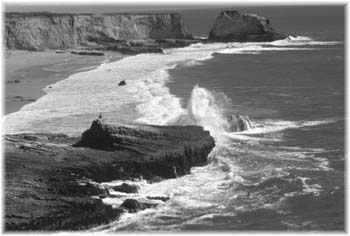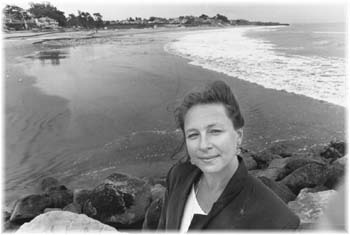![[MetroActive Features]](/features/gifs/feat468.gif)
![[MetroActive Features]](/features/gifs/feat468.gif)
[ Features Index | Metro Santa Cruz | MetroActive Central | Archives ]
Woman Overboard
Stormy Seas: The turbulent waters of the Monterey Bay National Marine Sanctuary reflect a months-long controversy that has left the agency without a leader and Washington's commitment in doubt.
Local environmentalists fear Washington's hiring screw-ups prove the feds don't respect the Monterey Bay Marine Sanctuary
By Jill Duman
IN THE WAKE of an announcement last week that the woman selected to manage the Monterey Bay National Marine Sanctuary had been reassigned, local environmentalists say they're mystified and outraged.
The hiring process, many say, was botched from the beginning, and local concerns weren't given enough credence.
Carol Fairfield, a resources specialist with the National Marine Fisheries Service in Maryland, was hired in April to take over as manager of the sanctuary, which covers 5,236 square miles from Big Sur to the Golden Gate. She was chosen after two public selection processes and was slated to begin work on July 14. At the June meeting of the Sanctuary Advisory Council, Fairfield was publicly introduced as the successor to Terry Jackson, who has managed the sanctuary since 1993.
Members of the advisory council say that Fairfield was on her honeymoon, en route from the East Coast to her new job, when she got word that she would not be reporting to the post.
Fairfield declined to speak to reporters. Stephanie Thornton of the National Oceanic and Atmospheric Administration (NOAA), reached in Maryland, said she can't comment because this is a personnel matter.
Vicki Nichols of Save Our Shores, one of six finalists in an earlier round of interviews for the position--and the only local contender considered--says it appears that the federal agency has handled the situation "very poorly."
"In my experience with the federal government, and in many of my colleagues' experience, nothing quite this drastic has ever happened before," Nichols says. "Because this community is so invested in the sanctuary, and because many of us are very involved in it publicly, this was seen as a very significant move for Washington to make. And it was done in a very unprofessional way."
Rachel Saunders, a member of the sanctuary advisory council who represents the Center for Marine Conservation, also criticizes the way the feds handled the hiring and dismissal.
"There was an interview process involving extensive work and a lot of local participation," Saunders says. "You would think that if there were problems with the person they chose, that would have come out during the cross-checks in the interview process.
"What we really need is someone within the [U.S.] Department of Commerce, which runs this agency [NOAA], to step up to the plate and assert some leadership."
To that end, Thornton was invited to the advisory council's retreat, which took place July 31 in Cambria.
David Iverson, an advisory council member who served on the original committee that helped form the sanctuary, said before the meeting that he intended to press for details about what happened and why.
"I think we're going to ask for clarification of just what happened in view of the fact that the Sanctuary Advisory Council had a very visible role in the interview process," Iverson said.
Other members of the council have phoned and written to NOAA's Silver Spring, Md., offices, communicating with both Thornton and Thornton's supervisor, Nancy Foster.
Greg Cailliet, an advisory council member and founder of the Research Activities Panel, said he "hit the roof" when told of Fairfield's reassignment. In an irate July 16 letter to Foster, Cailliet said he felt the decision to reassign Fairfield "will stimulate a crisis of confidence with the ... sanctuary program and further promote a gap between local sanctuary activities and the action of those in the NOAA administration."
He also told Foster that "many of us are personally offended that such an uninterpretable and apparently irrational action be taken after such a long process was fairly followed and a competent candidate chosen."
Hire Calling: Save Our Shores' Vicki Nichols was the only local candidate in the first phase of a hiring process that once again has failed.
Snafu, Part 2
CAILLIET AND OTHER ADVISORY council members say Fairfield's sudden reassignment is simply the latest screwup in a selection process marred from the beginning by inexplicable problems. The search to replace Jackson began last fall. After a national search, the field was narrowed to six candidates who were interviewed extensively by national marine officials and local environmentalists in a very public process. Then, in November, the results of that search were jettisoned, with Thornton announcing that she had decided to re-advertise the position.
"A lot of money was spent on bringing people from Washington for days at a time," says Nichols. "Sanctuary Advisory Council people left their jobs to be part of this."
"It is clear that the manager's position is very complex and demands a broad set of skills and expertise in order to be successful," wrote Thornton in a memo to Cailliet dated Dec. 15, 1996. "I want to reiterate that those skills and expertise were not identified or known until I spent time personally talking and listening to the concerns and issues in the Monterey region."
When the sanctuary job was advertised for a second time, insiders say, the description was slightly rewritten to de-emphasize scientific background and underscore management skills.
"What I will say about the second round is that it was heavy on administrative capabilities, but that doesn't make sense for a job that should be science-oriented," Townsend says.
Sanctuary Advisory Council members also participated in the second round of interviews for the manager post, and most said they thought Fairfield was an excellent choice.
"Carol Fairfield has excellent credentials," Townsend says. "She's got a lot of science background, and I think she would make a splendid manager."
In the absence of an official explanation, there's plenty of inside speculation about why Fairfield's appointment was shelved.
"Because this is a personnel matter, it's a sensitive and delicate balance between communicating with the community and honoring and respecting the sensitivity of personnel issues," Thornton says. "That's the reason why not a lot of information has been able to go out."
Some council members speculate that Fairfield's views in support of the Acoustic Thermometry and Ocean Climate program (ATOC)--which would measure global ocean temperatures using underwater sonic blasts--may have hurt Fairfield's chances with Thornton, whose division opposed ATOC two years ago.
This new acoustic test, currently being proposed by the Navy for the sanctuary, may soon mean rehashing all the controversial arguments that made ATOC a divisive issue in the local marine community--a scenario that would have spotlighted Fairfield's pro-ATOC views.
Conversely, others say the new manager would have been too sensitive to local concerns for NOAA managers in Maryland.
In any case, Fairfield's fate--and the fate of the sanctuary--will be the focus of ongoing attention.
"I am concerned this will have a ripple effect on our search for a new leader," Nichols says.
"The bottom line is it's a complete disservice to the sanctuary, and it's kind of a slap in the face to the local communities," Saunders says. "Thank God the ocean is still big and blue and filled with marvelous creatures."
Copyright © Metro Publishing Inc. Maintained by Boulevards New Media.

Shmuel Thaler

Robert Scheer
From the August 6-13, 1997 issue of Metro Santa Cruz.